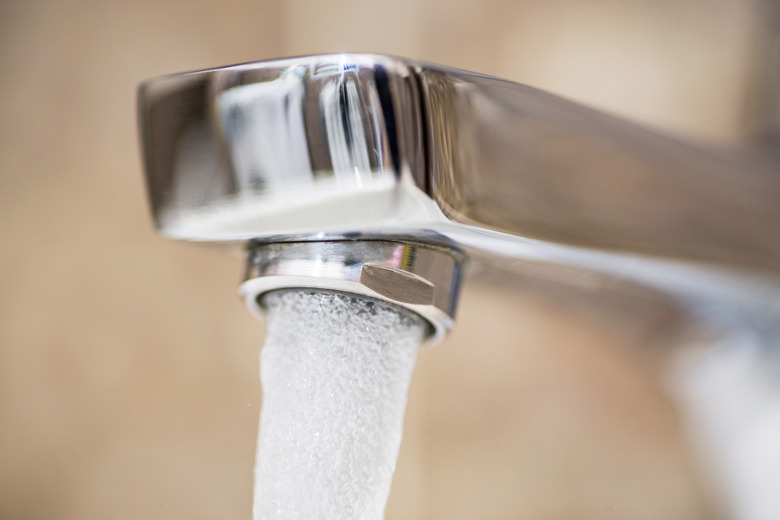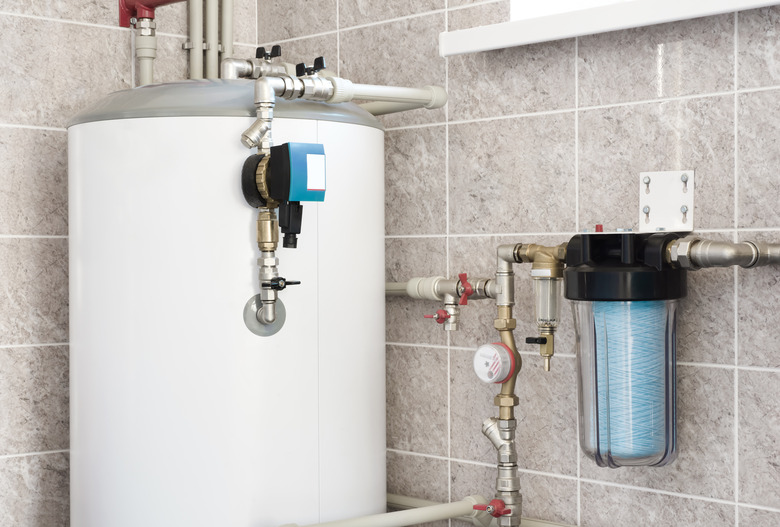Can I Drink Tap Water After An Earthquake?
We may receive a commission on purchases made from links.
It's impossible to predict the extent of the damage after a major disaster, but if the disaster is an earthquake, one thing is virtually certain: There will be broken water mains or plumbing pipes. Even earthquake-resistant housing can experience water supply issues after an earthquake. That usually means that drinking water is cut off completely, but in some instances, there may still be enough pressure to deliver water to the faucets. You're right to be concerned about consuming that water, especially if it comes from a well.
Tip
Drinking water is often compromised after an earthquake. If it's contaminated or if you're not sure, you should use your emergency water supply or treat water from the tap using heat or chemicals.
Condition of Tap Water
Condition of Tap Water
The condition of the drinking water after an earthquake is as difficult to predict as the extent of the total earthquake damage you'll experience. A few telltale signs can alert you to the likelihood of contamination, and if you're well prepared, your emergency supplies will include a water test kit that will let you assess the water definitively. If your taps are still flowing, the water may be fine, but if you aren't sure, it's best to drink the water you stored in your pantry as part of your emergency preparations.
If you don't have an adequate supply of emergency water, you'll have to purify the tap water. You can do this using heat or chemicals. If the taps aren't running at all, you can get water from a number of sources, including the water heater and the toilet tank (not the bowl). Wherever the water comes from, it's a good idea to purify that water before you drink it.
Mineral Contamination in Tap Water
Mineral Contamination in Tap Water
After an earthquake hits, check for signs of water contamination. A breach in the water supply chain can introduce mineral impurities. They will probably change the water color, although, because they dissolve slowly, it will take a few days for this to happen. If the water coming out of the tap is yellow or brown, it almost surely contains iron.
A black coloration indicates manganese, and green usually indicates copper. Although these minerals are toxic in high doses, the human body does not efficiently absorb them from water, so technically, mineral-laden water is safe—if unpleasant—to drink in small quantities.
Pathogen Contamination in Tap Water
Pathogen Contamination in Tap Water
Of more concern are pathogens that may enter the water system through a collapsed well or a broken pipe. To keep your family safe during an earthquake, make sure you have uncontaminated drinking water. Water that contains amoebae or bacteria is often also discolored, but the discoloration comes from sediment and dirt, not the pathogens. Depending on the degree of contamination, the water coming from the tap may just be cloudy, or it may be brown, and it may have an odor.
If the water comes out of the tap at full pressure and it's clear and odor-free, the water supply system is probably intact, and the water is probably safe. It's still a good idea to test it before you drink it. If you don't have a test kit, it's prudent to use your emergency water supply until you get the water tested.
It is best to test for pesticides as well as bacteria. A breach in the system could allow groundwater to carry pesticides into the water supply. A test kit that detects both pesticides and bacteria costs about $25.
Purifying Contaminated Water
Purifying Contaminated Water
If water contamination happens in your home after an earthquake, the most reliable way to purify the contaminated water is to boil it. Bringing the water to a rolling boil for at least a minute kills bacteria, viruses and protozoa. While boiling won't remove mineral discoloration, it will clarify water that has been clouded by organic contaminants.
After boiling, allow the water to cool to room temperature, preferably in a covered container, before using it. Boiled water tends to have a flat taste, and if that bothers you, add a pinch of salt per quart.
Alternatives to Boiling Water
Alternatives to Boiling Water
It's frequently unsafe to use fire after an earthquake because gas lines may have ruptured. There are several alternatives to boiling for water purification. Here are some common ones that use substances you should be able to find easily:
- Unscented liquid household bleach: Add 8 drops of chlorine bleach to each gallon of clear water to treat it. If the water is cloudy, increase the concentration to 16 drops per gallon. Shake or stir the water and let it stand for 30 minutes before using it. Avoid scented bleach, because the chemicals that create scents are harmful.
- Granular calcium hypochlorite: If you have a swimming pool, you can use the calcium hypochlorite you use to treat the pool water to purify your drinking water. The procedure involves two steps:
- Dissolve a heaping teaspoon of calcium hypochlorite granules into 2 gallons of water and stir until the granules have dissolved. It's best to wear eye protection when doing this.
- Add the bleach solution to contaminated water in a 1:100 ratio—that is, 1 part bleach for 100 parts water.
- Tincture of iodine: If you have 2 percent tincture of iodine in your medicine cabinet, add 5 drops to each quart of clear water. If the water is cloudy, add 10 drops.
It's also possible to treat contaminated water with hydrogen peroxide (H2O2), but it's not recommended. If it's the only thing you have on hand, add 1/8 cup of medicine-grade (3%) hydrogen peroxide per gallon of water.
Emergency Sources of Drinking Water
Emergency Sources of Drinking Water
If the faucets aren't running, you'll have to rely on your emergency water supply until you can get help. Part of emergency preparedness is to store enough bottled water so that each person has enough to last for 72 hours at the rate of 1 gallon per person per day. In the absence of bottled water, you can get emergency water from other sources. With any of these emergency sources, it is best to disinfect the water through chemical means or boiling. Options include:
- The water heater: Screw a garden hose onto the drain plug and empty as much water as you need into a clean bucket to store. A 40-gallon tank holds an ample 3-day supply for the entire family.
- Toilet tanks: Siphon water out of the tanks using a hose or rubber tube. Do not use water that contains a disinfectant, and do not use water from the bowl.
- Ice cubes. Place any ice cubes you have in the freezer in a clean bucket and let them thaw.
- River or lake water: If you live near a large body of water, you may have to rely on it for drinking water. Draw water from areas in which it is flowing, not stagnant areas. Do not use discolored water or water on which any debris is floating.
Unsafe sources of drinking water include swimming pools, boilers and radiators for home heating systems, and water beds. You may be tempted to purify water using a reverse osmosis or activated charcoal filter, but this isn't recommended, because these filters do not reliably remove microscopic pathogens. A purifier that employs ultraviolet radiation or a ceramic filter, however, is safe to use.

